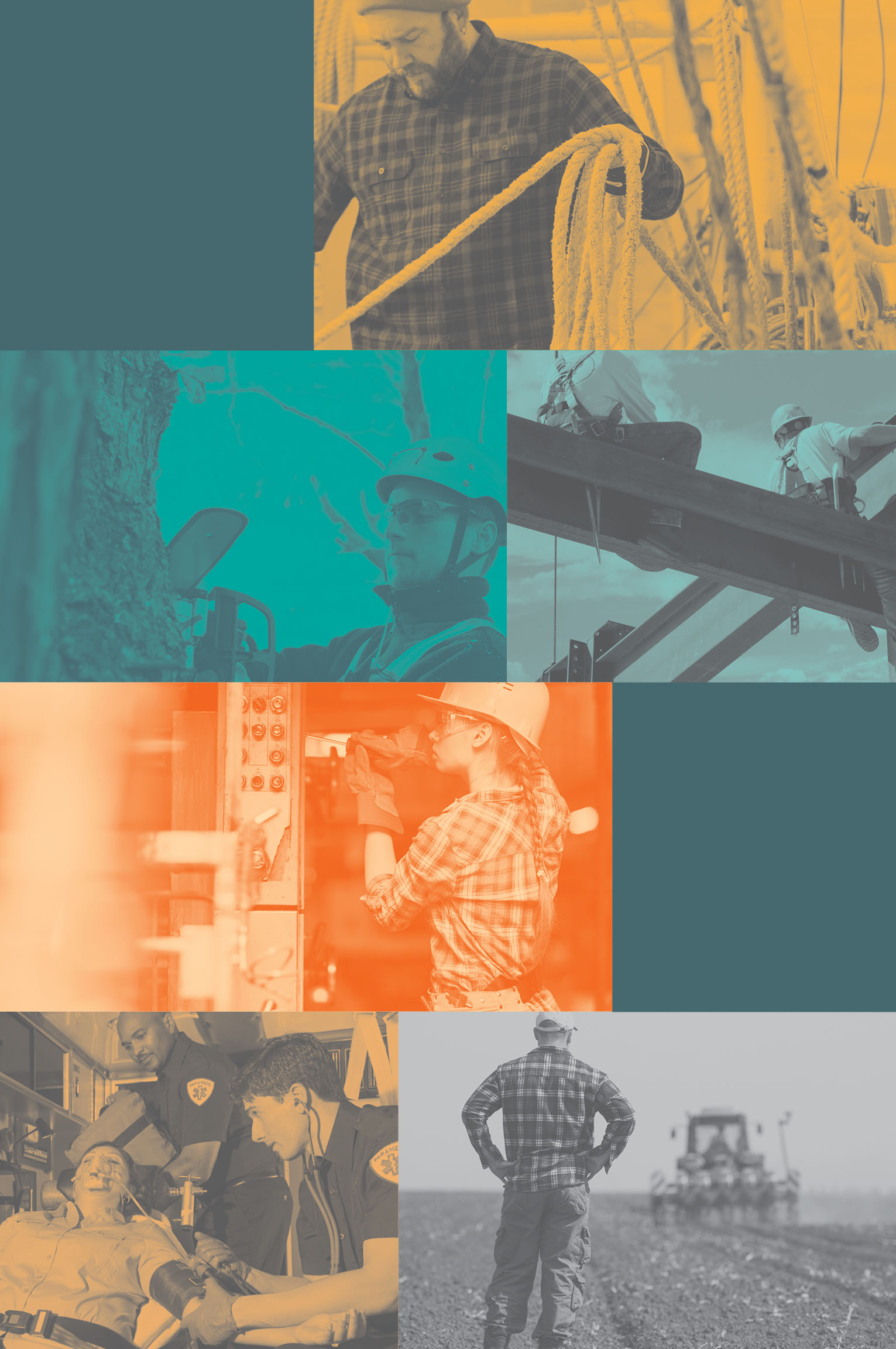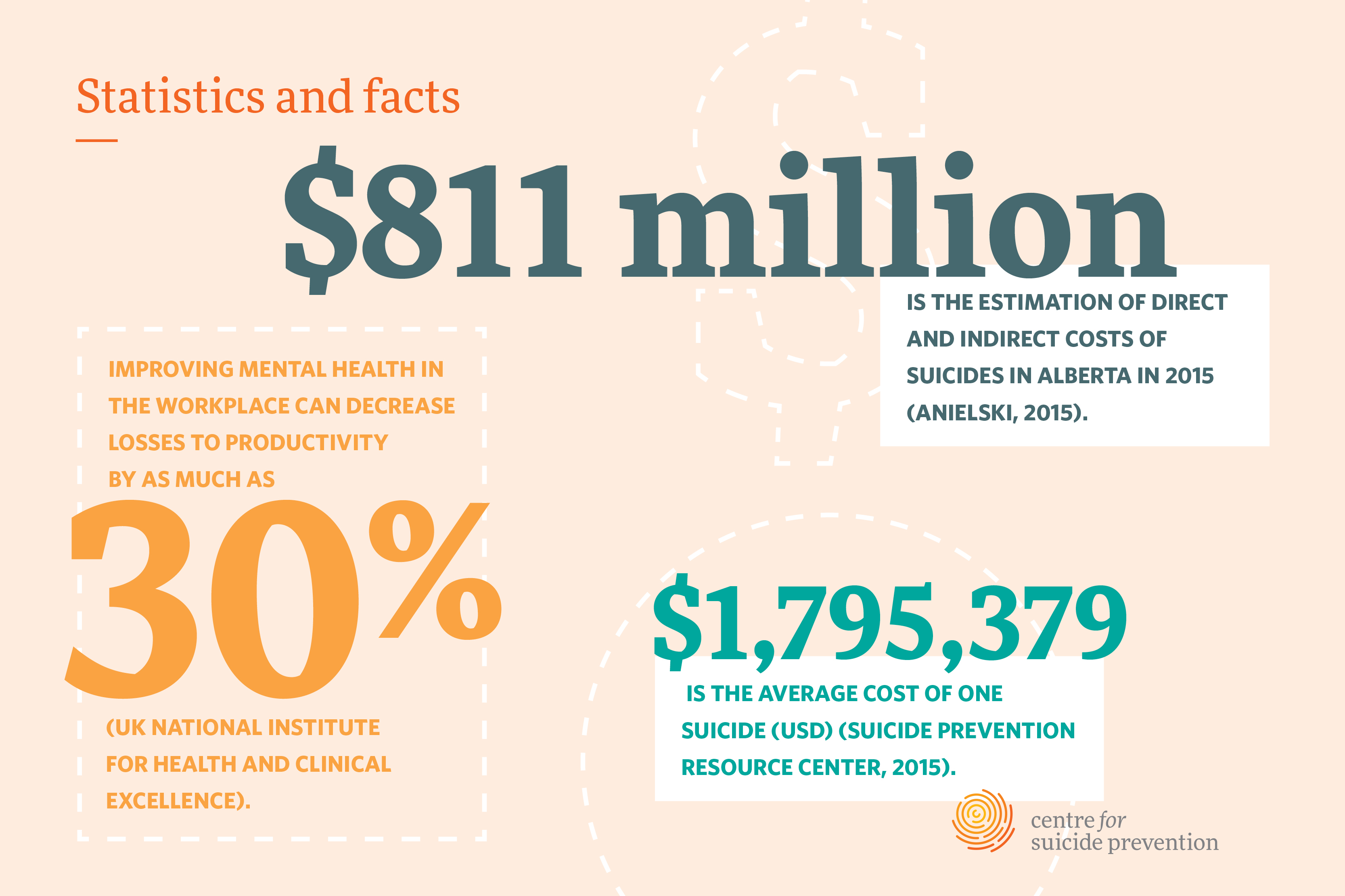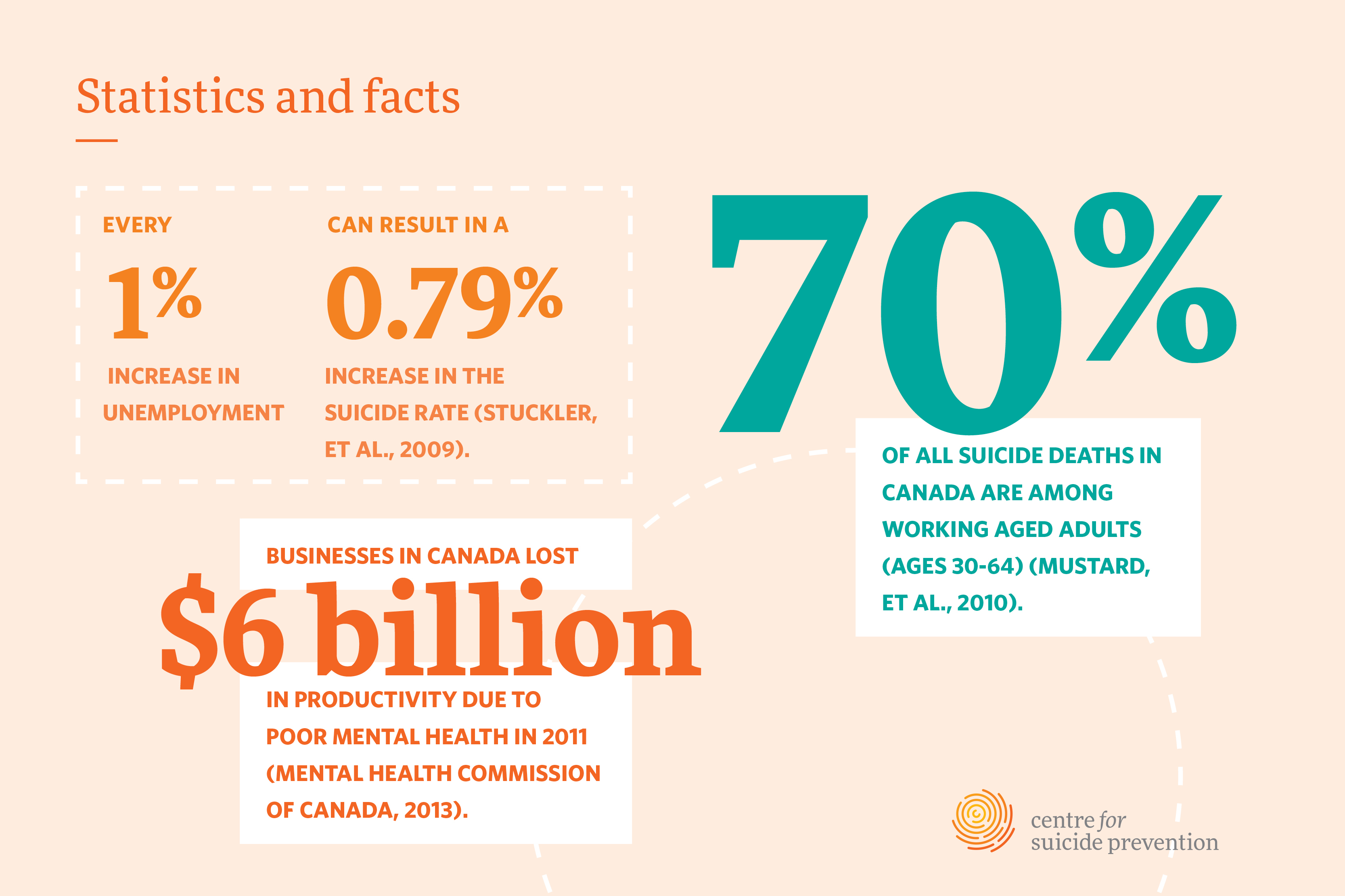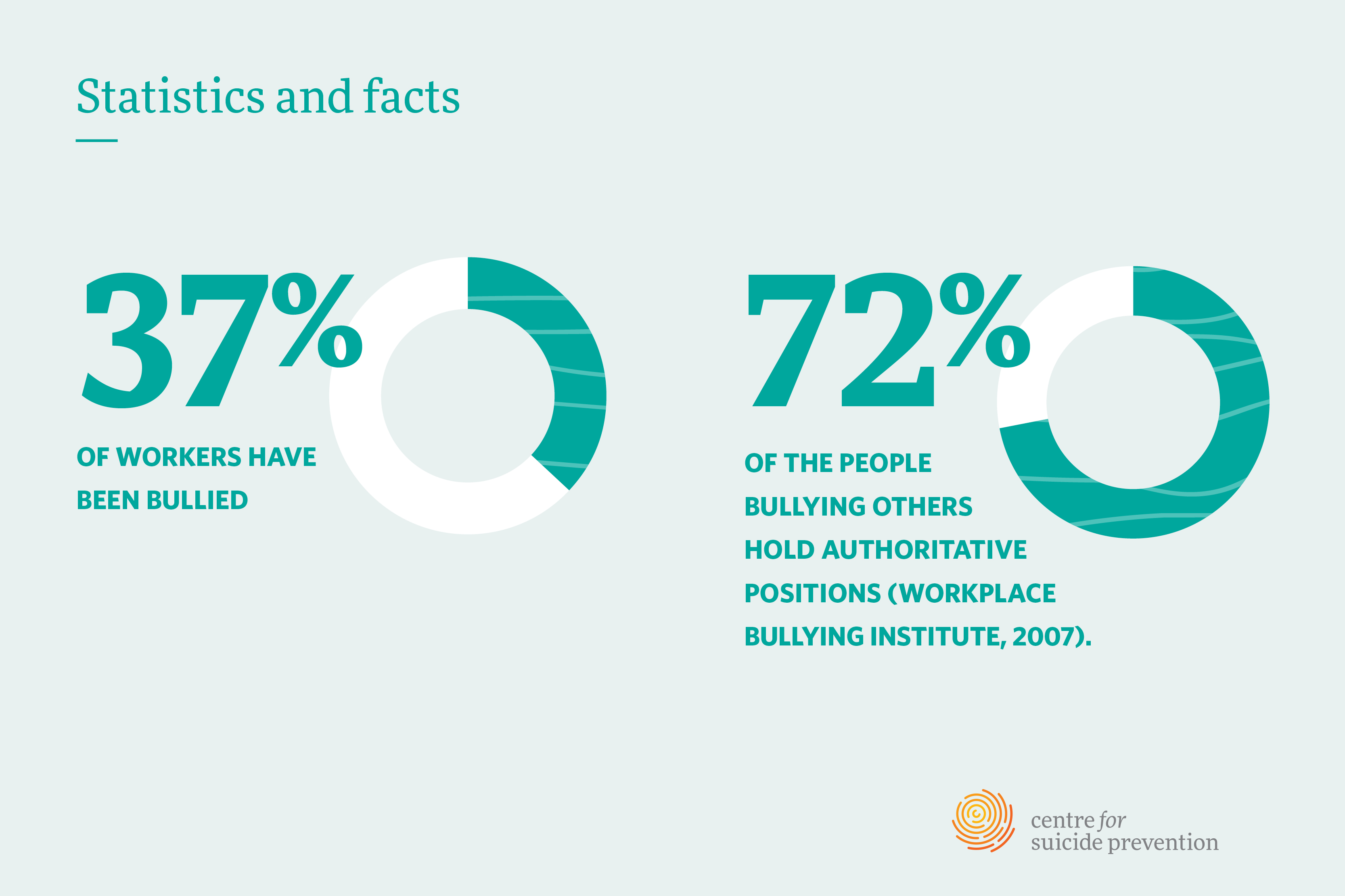
The workplace is a major part of the lives of most Canadians. Many of us spend upwards of 60% of our waking hours at work (Canadian Association for Suicide Prevention, 2016). Therefore, when a colleague dies by suicide the emotional and financial costs are enormous not only to family members, but to co-workers and the organization itself. Workplaces need to have measures in place to inform and educate about suicide. It is an issue that cannot be ignored.
This toolkit is a collection of facts, figures, and best preventative practices regarding suicide in the workplace.

Workplace warning signs
People who are suicidal typically exhibit warning signs. In the workplace, these changes may be identified as a person:
- Being very happy after a period of depression;
- Acting more aggressive or stressed out than usual (e.g. lashing out at people);
- Commenting on being tired all the time, being noticeably fatigued;
- Commenting about being a burden to others (e.g. “Everyone would be better off if I wasn’t here”);
- Not showing up for work as often or being absent for periods of time (absenteeism); and
- Not being as productive as usual, being un-motivated (presenteeism).
Some warning signs require more immediate action than others. If someone is exhibiting the following warning signs, call 9-1-1:
- Talking about wanting to die or to kill oneself; and
- Looking for a way to kill oneself or already having a plan.
(American Association of Suicidology, 2017)

Occupations with high suicide rates
People in occupations where some of the following factors are present generally have higher suicide rates:
- easy access to lethal means (e.g. guns, pesticides);
- exposure to chemicals (e.g. pesticides) that can cause mood or behaviour impairments;
- high workplace stress (e.g. trauma, dangerous working conditions);
- job insecurity (e.g. contract work);
- low wages;
- stressors related to gender imbalance (women working in traditionally male-dominated industries); and
- inconsistent work schedule (e.g. shift work) which can cause a disruption of family routine, inconsistent sleep patterns and other challenges; and
- isolation in the workplace.
Occupations with the highest rates of male suicide include (per 100,000):
- Construction workers (53.2);
- Installation, maintenance, and repair workers (39.1); and
- Farmers, ranchers, and other agricultural managers (32.2).
Occupations with the highest rates of female suicide include (per 100,000):
- Arts, design, entertainment, sports, and media professionals (15.6);
- Protective services (e.g. police) (12.2); and
- Health care support (11).
(Peterson et al., 2018)
More research is needed to understand occupation-specific risk factors and develop evidence-based programs for the workplace (Tiesman, et al., 2015).
Suicide prevention at work
Prevention measures
- Employee assistance programs or human resource departments are available to help employees access mental health services (SPRC, 2013)
- Promotion of mental health (such as paid mental health days, sufficient vacation time, benefits that acknowledge both physical and mental health services)
- Suicide prevention awareness and training
- Fostering a culture where help-seeking is encouraged
How to talk to a co-worker you think may be suicidal
- Mention you have noticed changes in their behaviour and that you are concerned about them
Hey, you seem to be a bit overwhelmed with all the work you’ve been getting lately. I notice you are a bit more distracted than usual and I’m a bit worried about you. Are you okay?”
- Ask them directly if they are having thoughts of suicide and if they a plan to kill themselves,
Sometimes when people feel overwhelmed they think of any way possible to escape their situation. Sometimes they even think about killing themselves. Are you thinking about suicide?”
- Connect them with resources in your organization (e.g. human resources, the employee assistance program or another mental health professional) or resources in your community.
(Suicide Prevention Resource Center, 2013)
After a suicide at work
When a suicide occurs in the workplace people in leadership roles need to respond swiftly and appropriately.
Immediately after a suicide, leadership should:
- send their condolences to the deceased person’s family;
- ask family members if they are comfortable with the leadership acknowledging the death as a suicide to other members of the organization;
- communicate the death to employees while respecting the family’s wishes; and
- follow any existing crisis response policy guidelines.
In the days and weeks following the suicide, leadership should:
- identify those employees most impacted by the death and ensure they receive the grief support they need;
- offer psychological resources and supports to all employees; and
- decide whether or not to memorialize the deceased.
In the months and years following the suicide, leadership should:
- ensure preventative measures (previously listed) are put in place.
(Carson J. Spencer Foundation, 2013; Canadian Association for Suicide Prevention, 2016)
Bullying in the workplace
Workplace bullying can contribute to:
- anxiety;
- panic attacks;
- depression; and
- higher risk of suicide for those already experiencing suicidal risk factors (e.g. previous attempts, family history of suicide, substance abuse).

Bullying includes:
- repeated intimidating or abusive behaviour;
- assertion of power through aggression; and
- calling attention to or mocking a person’s perceived shortcomings (including psychological or physical disabilities).
Bullying does not include:
- expressing differences of opinion;
- offering constructive feedback, guidance, or advice about work‑related behaviour; and
- reasonable management actions (e.g. managing a worker’s performance, disciplinary actions, assigning work).
(Canadian Centre for Occupational Health and Safety, 2017; Workplace Mental Health Promotion, 2017)
Resources
Breaking the silence in the workplace: A guide for employers on responding to suicide in the workplace
Irish Hospice Foundation
https://www.iasp.info/pdf/special_interest_groups/workplace/Breaking-the-Silence-in-the-Workplace-A-Guide-for-Employers-on-Responding-to-Suicide-in-the-Workplace.pdf
Critical Incident Stress Debriefing
http://www.info-trauma.org/flash/media-f/mitchellCriticalIncidentStressDebriefing.pdf
A Manager’s Guide to Suicide Postvention in the Workplace: 10 Action Steps for Dealing with the Aftermath of Suicide
Carson J. Spencer Foundation
http://actionallianceforsuicideprevention.org/sites/actionallianceforsuicideprevention.org/files/Managers-Guidebook-To-Suicide-Postvention-Web.pdf
Content from this toolkit was used to create our presentation for the Mental Health Commission of Canada’s Suicide prevention in the workplace webinar, available online.
References
The American Association Suicidology (2017). Know the warning signs of suicide. Retrieved from http://www.suicidology.org/resources/warning-signs
Anielski, M. (2015). The cost of suicide to Alberta. Retrieved from http://www.anielski.com/wp-content/uploads/2015/12/Suicide-and-Unemployment-in-Alberta.pdf
Canadian Association of Suicide Prevention. (2016). Becoming a suicide-safer workplace. Retrieved from http://suicideprevention.ca/understanding/workplace/becoming-a-suicide-safer-workplace/
Canadian Centre for Occupational Health. Bullying in the workplace. Retrieved from https://www.ccohs.ca/oshanswers/psychosocial/bullying.html
Carson J. Spencer Foundation, Crisis Care Network and the American Association of Suicidology (2013). A manager’s guide to suicide postvention in the workplace: 10 action steps for dealing with the aftermath of suicide. Denver, CO: Carson J. Spencer Foundation
Institute for Work and Health. (2010). Probing the link between occupation and risk of suicide. At Work, 61. Retrieved from https://www.iwh.on.ca/at-work/61/probing-the-link-between-occupation-and-risk-of-suicide
Mental Health Commission of Canada. (2013). Making the case for investing in mental health in Canada. Retrieved from http://www.mentalhealthcommission.ca/sites/default/files/2016-06/Investing_in_Mental_Health_FINAL_Version_ENG.pdf
Mustard, C., Bielecky, A., Etches, J., Wilkins, R., et al. (2010). Suicide mortality by occupation in Canada, 1991-2001. Canadian Journal of Psychiatry, 56(6), 369-376.
Peterson, C., Stone, D., Marsh, S., Schumacher, P., Tiesman, H., McIntosh, W., Lokey, C., Trudeau, A., Bartholow, B. & Luo, F.(2018). Suicide Rates by Major Occupational Group — 17 States, 2012 and 2015. Centers for Disease Control and Prevention. Morbidity and Mortality Weekly Report, 67(45), 1253-1260. Retrieved from https://www.cdc.gov/mmwr/volumes/67/wr/mm6745a1.htm?s_cid=mm6745a1_e
Stuckler, D., Basu, S., Suhrcke, M., Coutts, A. & McKee, M. (2009). The public health effect of economic crises and alternative policy responses in Europe: An empirical analysis. The Lancet, 374, 315-323.
Suicide Prevention Resource Center. (2015). Costs of suicide. Retrieved from http://www.sprc.org/about-suicide/costs
Suicide Prevention Resource Center. (2013). The role of co-workers in preventing suicide in the workplace. Retrieved from https://www.iasp.info/pdf/special_interest_groups/workplace/coworkers_suicide_prevention.pdf
Tiesman, H., Konda, S., Hartley, D., Menendez, C., Ridenour, M. & Hendricks, S. (2015). Suicide in U.S. workplaces, 2003-2010. American Journal of Preventative Medicine, 48(6), 674-682.
Workplace Bullying Institute. (2007). Workplace Bullying Survey. Retrieved from http://www.workplacebullying.org/research/WBI-Zogby2007Survey.html
Workplace Mental Health Promotion. (2017). Harassment, violence, bullying and mobbing. Retrieved from http://wmhp.cmhaontario.ca/workplace-mental-health-core-concepts-issues/issues-in-the-workplace-that-affect-employee-mental-health/harassment-violence-bullying-and-mobbing